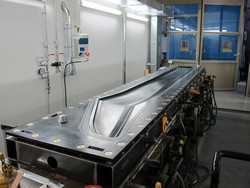Composite materials for high-performance mould tools
Common materials used to build RTMs, also known as tooling, include aluminium, steel and fibreglass. Material selection is based on a variety of factors such as part quantity, size and complexity, as well as finish quality and required cycle time. For high-volume production, moulds are usually heated and incorporate control systems to automate the entire process. Use of steel and metals as tooling materials has presented many challenges regarding the required energy and material input. Having also different properties from the fabricated composite part, they lead to deformation of the final part, which goes hand in hand with financial expenses. To address these challenges, the EU-funded project LEETORB (Lightweight, energy-efficient tooling for the manufacturing of rotor blades) proposed the use of carbon fibre as a tooling material instead. High strength and stiffness relative to their weight compared to metals was the reason for choosing composites as the material of choice. In addition, the low thermal mass leads to major reductions in energy use of up to 50 %. Researchers successfully performed a proof-of-principle of their ideas by unveiling RTM tooling based on fibre-reinforced plastic for production of helicopter rotor blades. To further enhance the production process and reduce energy, the team integrated a heating device that introduced heat where needed. A carbon roving was utilised as an electric conductor and stitched to a glass fabric. When attached to an energy source, the carbon roving acted as resistive heating and, depending on its pattern, it adjusted the heat input. Stiffening ribs and a steel frame were applied on the back of the carbon fibre shell to reduce the deformation caused by compaction and injection forces. Use of carbon fibre-reinforced plastic as the main material enabled lighter tooling devices in combination with more efficient heat-up and cooling. The newly developed prototypes enabled substantial savings in terms of energy input, from tool manufacturing to rotor blade production.
Keywords
Composite parts, resin transfer moulding, tooling, LEETORB, rotor blades

